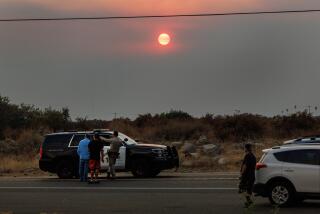EPA Tightens Gauge of Air Quality
WASHINGTON — The Environmental Protection Agency today will officially designate about 470 of the nation’s 2,700 counties as having air with unhealthful levels of ozone or smog, agency officials said Wednesday.
The designation coincides with a new, more protective standard that today becomes the country’s primary gauge for judging smog levels.
The ozone levels in many of the designated counties, which include 100 metropolitan areas and at least eight popular national parks, have actually dropped in recent years, EPA Administrator Mike Leavitt said in remarks to the National Press Club. However, there are still days when the levels are higher than is considered safe, he added.
“This isn’t about the air getting dirtier -- the air is getting cleaner,” Leavitt said. “It’s about our standards getting tougher and our national resolve to meet them.”
The new standard is likely to throw the Bay Area, Ventura County and Sacramento back on the list of unhealthy areas, said Jerry Martin, spokesman for the California Air Resources Board. Los Angeles and the Central Valley, which still had a long way to go to meet the old standard, will have to make even deeper cuts in pollution to have their air designated clean.
In 1997, the EPA decided a more protective standard for ozone was necessary because research had shown that even at low levels, ozone pollution was causing acute respiratory problems, aggravating asthma and impairing immune systems. Children, older individuals and people with fragile immune systems are most vulnerable. The standards were designed to reduce asthma attacks, hospital stays and chronic illness.
Under the old standard, air was considered unhealthful when it measured above 120 parts per billion of ozone over a one-hour period. Now air is considered unhealthful if it measures an average of above 85 parts per billion over an eight-hour period. Ozone is the primary component of smog.
Today’s announcement will more than double the number of counties considered to have harmful levels of ozone. Currently, 221 counties -- home to more than 110 million people -- violate the one-hour standard, according to EPA officials. The states in July suggested that 412 counties should be on the new list, but the EPA in December proposed naming 506 counties. Agency officials refused to specify which counties fell off the list or why.
Leavitt described the new ozone policy as a key part of the Bush administration’s strategy to launch “one of the most productive periods of air quality improvement in our nation’s history.”
Other new initiatives include the designation later this year of counties that violate a new health-based standard for fine particulates, or air pollutants that cause heart and lung problems and are responsible for thousands of early deaths. Another would reduce air pollution from power plants in 28 Eastern states by capping the amount of allowable emissions. It would also allow plants that reduce their pollution faster to sell “emissions credits” to those that are slower to clean up. A third initiative would regulate emissions of mercury from coal-fired power plants.
These new policies show that the government is “picking up the pace” in improving air quality, Leavitt said, adding, “This is a great success story on behalf of this administration.”
But state officials, congressional Democrats and environmental groups said the administration had repeatedly made decisions that slowed the progress toward cleaner air.
For instance, they said, the EPA gave power plants and other major polluters exemptions from a Clean Air Act provision requiring them to install modern pollution controls when they significantly expand or modify older facilities and increase pollution. And the agency’s mercury proposal would cut emissions of the toxin much more slowly and less deeply than required under the act, according to the critics.
In all these cases, critics accused the administration of giving polluting industries, especially coal-fired power plants, too much say in the writing of the rules that regulate them.
Among those critics is Jeremy Symons, an air pollution specialist at the National Wildlife Federation and a former EPA official.
“Across the board, the administration is taking industry’s side to delay or weaken enforcement of the Clean Air Act,” Symons said Wednesday.
More to Read
Sign up for Essential California
The most important California stories and recommendations in your inbox every morning.
You may occasionally receive promotional content from the Los Angeles Times.










